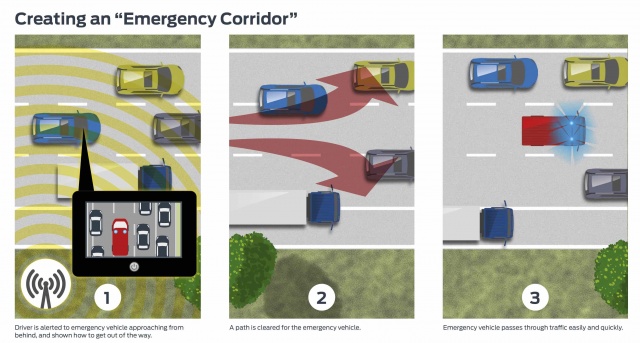What's the news?
Ford, in partnership with Vodafone, is working on a prototype technology that can help drivers get out of the way of emergency services vehicles that are responding to incidents.
Research shows that survival rates for road accident victims are improved by up to 40 per cent if they receive earlier treatment (by four minutes), which means every second counts for a first responder unit - but, if traffic impedes their route, then vital time is lost.
However, the Ford and Vodafone technology could alert drivers about an accident that has occurred ahead of them, on their route, just moments after it has happened - and it can then alert the driver to any emergency vehicles that are approaching the crash scene from their direction of travel, instructing them which side of the road to move to in order to avoid being an obstruction.
The systems is designed to facilitate an 'emergency corridor' for fire engines, ambulances and police vehicles to travel along, which - in some countries - is already a legal requirement for queuing traffic.
Ford says the technology is being trialled as part of a €15 million programme called KoMoD, based in Dusseldorf, Germany. It would build on Ford's existing technologies, like eCall, which is already available on the new Ford Focus and which can automatically call emergency services or connect with them if the occupants push an SOS button inside the car.
The new system would work in a future road system where vehicles are all connected by vehicle-to-everything (V2X) communications, allowing them to inform other drivers of an accident in the fastest possible time.
Gunnar Herrmann, CEO of Ford of Germany, said: "Connected and automated driving are key technologies of the future. Ford has a long history of developing and testing vehicle to traffic infrastructure and vehicle to vehicle communications that can contribute to greater road safety and efficiency across the world. Together with Vodafone and in cooperation with the other companies involved, we will gain decisive insights on the Düsseldorf testing grounds to further advance the networking of vehicles."
Hannes Ametsreiter, CEO of Vodafone Germany, added: "The digital revolution is bringing new forms of mobility which may help save lives on our roads. When cars communicate with each other, our rescue teams get a clear path forwards, so they can provide the right help at the right time, in situations when every second counts."
Anything else?
Ford is also testing further technologies at KoMoD, such as a Traffic Light Assistance System to advise on the timing of traffic lights and a Tunnel Information System, which uses messages roadside units to display to the driver warning messages about speed limits, slowly moving vehicles or lane closures.


